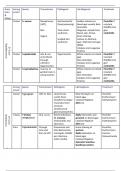Summary Personality Psychology: Domains of Knowledge About Human Nature
(Larsen, Buss)
Chapter 1, 2, 3, 4, 5, 10, 11, 12, 13, 14, 15, 16, 17 and Lecture Notes
Chapter 1: Introduction to Personality Psychology
Chapter 2: Personality Assessment, Measurement and Research Design
(Part 1, the Dispositional Domain)
Chapter 3: Traits and Taxonomies
Chapter 4: Theoretical and Measurement Issues in Trait Psychology
Chapter 5: Personality Dispositions over Time: Stability, Coherence and Change
(Part 3: The Intrapsychic Domain)
Chapter 10: Psychoanalytic Approaches: Contemporary Issues
Chapter 11: Motives and Personality
(Part 4: The Cognitive/Experimental Domain)
Chapter 12: Cognitive Topics in Personality
Chapter 13: Emotion and Personality
Chapter14: Approaches to the Self
Chapter 15: Personality and Social Interaction
Chapter 16:Sex, gender and personality
Chapter 17: Culture and Personality
,
,Chapter one: Introduction to Personality Psychology
Personality is the set of psychological traits and mechanisms within the individual that are
organized and relatively enduring and that influence his or her interactions with, and adaptions to,
the intrapsychic, psychical and social environments.
Psychological traits are characteristics that describe ways in which people are different from each
other.
Traits describe people’s average tendencies.
Psychological traits are useful for at least 3 reasons:
1. They help describe people
2. They help explain behavior
3. They can help predict behavior
Psychological mechanisms are like traits, except that the term mechanisms refers more to the
processes of personality. For example, most psychological mechanisms involve an
informationprocessing activity (someone who is extraverted may look for and notice opportunities to
interact with other people. That person is prepared to notice and act on certain kinds of social
information).
Most psychological mechanisms have 3 essential ingredients:
1. Input
2. Decision rules
3. Outputs
A psychological mechanism may make people more sensitive to certain kinds of information
from the
environment (input), may make them more likely to think about specific options (decision
rules) and
may guide their behavior toward certain categories of action (outputs). Example: an extraverted
person may look for opportunities to be with other people, may consider in each situation the
possibilities for human contact and interaction, and may encourage others to interact with
him/her.
This doesn’t mean that all of our traits and psychological mechanisms are activated at all
times. Every
trait is activated only under particular conditions.
Personality is something a person carries with himself over time and from one situation to the
next.
The definition of personality stresses that the important sources of personality reside within
theindividual and, hence, are at least somewhat stable over time and somewhat consistent
over
situations.
,Personality is organized because the mechanisms and traits are linked to one another in a
coherent
fashion. Our personalities are organized in the sense that they contain decision rules that
govern
which needs are activated, depending on the circumstances.
Psychological traits are also relatively enduring over time, particularly in adulthood, and are
somewhat consistent over situations. There may be situations where the generalization about
the
consistency of personality from situation to situation doesn’t hold; some situations may be
overpowering and suppress the expression of psychological traits.
In the definition of personality, an emphasis on the influential forces of personality means that
personality traits and mechanisms can have an effect on people’s lives; personality plays a
key role in
affecting how people shape their lives. It Is in this sense that personality traits are thought of
as
forces that influence how we think, act, and feel.
Interactions with the environment
The nature of person-environment interaction is complex.
Perceptions refers to how we see or interpret an environment, which is a result of personality.
Selection describes the manner in which we choose situations to enter and is, at least in part,
a
reflection of our personalities.
Evocations are the reactions we produce in others.
Manipulations arethe ways in which we intentionally attempt to influence others.
A central feature of personality concerns adaptive functioning (accomplishing goals, coping,
etc.). By
knowing the adaptive consequences of disordered behavior patterns, we begin to understand
some
of the functional properties of normal personality.
The environment
The physical environment often poses challenges for people, and the way we cope with our
environment, is central to an understanding of personality.
Personality can be analyzed at three levels (Kluckhohn & Murray, 1948). Murray stated that
every
human being is, in certain respects;
1. Like all others; the human nature level (traits and mechanisms of personality that are
typical of our
species and are possessed by (nearly) everyone.
2. Like some others; the level of individual and group differences
3 Like no others; the individual uniqueness level
,Most of the grand theories of personality address the human nature level of analysis; these
theories
tempt to provide an universal account of the fundamental psychological processes and
characteristics of our species.
Most of the empirical research in contemporary personality addresses the ways in which
individuals
and groups differ.
The six domains of knowledge about human nature
1. Dispositional domain; deals centrally with the ways in which individuals differ from one
another;
the dispositional domain cuts across all the other domains. The reason for this is that
individuals can
differ in their habitual emotions, concepts of self, psychological propensities and even their
intrapsychic mechanisms. What distinguishes the dispositional domain is an interest in the
number
and nature of fundamental dispositions. The central goal of personality psychologists in this
domain
is to identify and measure the most important ways in which individuals differ from one
another.
2. Biological domain; humans are collections of biological systems, and these systems provide
the
building blocks for behavior, thought and emotion. This domain focuses on three areas of
research:
-Genetics
- Psychophysiology
- Evolution
3. Intrapsychic domain; deals with mental mechanisms of personality which operate outside of
conscious awareness (Freud’s theory of psychoanalysis)
4. Cognitive-experiential domain; focuses on cognition and subjective experience, such as
conscious
thoughts, feelings, beliefs and desires about oneself and others.
5. Social and cultural domain; Personality affects, and is affected by, the social and cultural
context.
,6. Adjustment domain; Personality plays a key role in how we cope, adapt and adjust to the
ebb and
flow of events in our day-to-day lives.
The role of personality theory
A good theory is one that fulfills three purposes in science:
- Provides a guide for researchers
- Organizes known findings, and
- Makes predictions.
Standards for evaluating personality theories:
- Comprehensiveness
- Heuristic value
- Testability
- Parsimony
- Compatibility and integration across domains and levels.
,Chapter two: Personality assessment measurement, and research design
Issues in personality assessment
Links among various data sources
A key issue that personality psychologists must address is how closely the findings obtained
from one
data source correspond with findings from another data source.
Depending on the personality variable under consideration, agreement across date sources
tends to range from low to moderate. Ozer and Buss (1991) examined the relationships
between
self-report and spouse-report for eight dimensions of personality. They found that the
agreement
varied depending on the particular trait and on the observability of that trait. Traits that are
easily
observable (extraversion) show a higher degree of self-observer agreement than do traits that
are
difficult to observe (such as calculating) and require inferences about internal mental states.
By using multiple measures from various data sources, researchers are able to average out
these
idiosyncrasies and home in on the key variable under study.
A major issue in evaluating linkages among the sources of personality data is whether the
sources are
viewed as alternative measures of the same construct, or as assessments of different
phenomena.
Lack of agreement does not necessarily signify an error of measurement, it may instead
signify that
observers are basing their conclusions on different behavioral samples.
Strong agreement between two sources of data may mean that alternative measures are
tapping
into the same personality phenomenon (extraversion and activity level), lack of strong
agreement
may mean that the different data sources are assessing different phenomena, or may indicate
that
one or more data sources are fallible or have problems.
One powerful strategy of personality assessment is to examine results that transcend data sources;
triangulation.
Evaluation of personality measures
Reliability can be defined as the degree to which an obtained measure represents the true level
of the trait being measured.
One way to estimate reliability is through repeated measurement.
Another way to gauge the reliability of a scale is to examine the relationship among the items
themselves at a single point in time. If the items within a test – viewed as a form of repeated
, measurement – all correlate well with each other, then the scale is said to have high internal
consistency reliability.
A third way to measure reliability (only for o-data) is to obtain measurements from multiple
observers. When different observers agree with each other, the measure is said to have high
interrater
reliability.
Response sets
- Noncontent responding: responding to the questions on a basis that is unrelated to the
question content
- Acquiescence: (or yea saying) to simply agree with the questionnaire items, regardless of
their content
- Extreme responding: to avoid the middle part of response scales
- Social desirability (sociale wenselijkheid)
2. Validity
Refers to the extent to which a test measures what it claims to measure. The simplest facet
of
validity is face validity.
Face validity: refers to whether the test, on the surface, appears to measure what it is supposed to.
Predictive validity: refers to whether the tests predicts criteria external to the test (risk taking;
parachute jumping as variable)
Convergent validity: refers to whether the test correlates with other measures that it should
correlate with (self- and peerassessment)
Discriminant validity: refers to knowing what the test doesn’t measure (doesn’t correlate with
what
it isn’t supposed to correlate with)
Construct validity: test measures what it claims to, correlates with what it is supposed to, and
does
not correlate with what it isn’t supposed to correlate with (personality variables are theoretical
constructs)
3. Generalizability: the degree to which the measure retains it’s validity across various contexts
Research designs in Personality
Experimental methods are typically used to determine causality; does one variable influence






